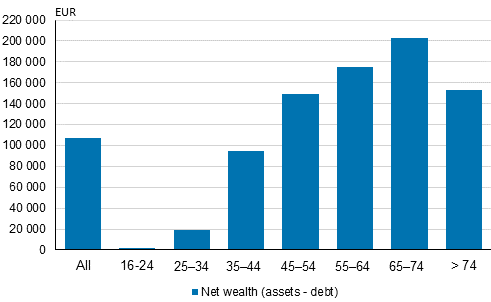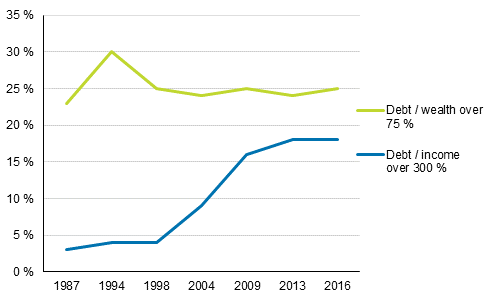Published: 5 June 2018
One-half of all households had a net wealth of over EUR 107,200 in 2016
Statistics Finland's Household Wealth Survey for 2016 indicates that the median for households' net wealth was EUR 107,200 in 2016. One-quarter of households had a net wealth of over EUR 260,900 and one-quarter under EUR 10,700. Households of those aged 65 to 74 were the wealthiest.
Average wealth according to the age of the household's reference person in 2016, median

The average net wealth was around EUR 206,600 per household or nearly double compared to the median. The ratio describes wealth concentration on the highest-income decile that owned some 47 per cent of net wealth in 2016. The five least wealthy deciles, or one-half of households, owned around six per cent of net wealth.
Distribution of net wealth in 1994, 2009, 2013 and 2016, shares of total amount of net wealth (%)
| Net wealth decile group | 1994 | 2009 | 2013 | 2016 |
| I–V (least wealthy 50 %) | 6.9 | 6.4 | 6.7 | 6.1 |
| VI | 8.2 | 6.9 | 6.9 | 6.5 |
| VII | 10.9 | 9.7 | 9.6 | 9.2 |
| VIII | 14.5 | 13.6 | 13.0 | 12.7 |
| IX | 20.3 | 19.4 | 18.7 | 18.8 |
| X (wealthiest 10 %) | 39.2 | 43.9 | 45.2 | 46.8 |
| Total | 100 | 100 | 100 | 100 |
Differences in wealth increased somewhat from 2013 to 2016, as the share of net wealth of the highest-income decile grew. Methodological changes in the statistics make long-term examinations difficult but compared to 1994, the wealth share of the highest-income decile has grown clearly.
The net wealth of the wealth survey is obtained by adding up real and financial assets and by deducting debts from them. Households’ most commonly owned asset types are deposits, transport equipment (73% of households), own dwelling (66%) and listed shares and mutual shares (41%). Measured by the value of the asset, own dwelling was clearly the biggest asset item as its share of total assets was around one-half.
Three households out of five had debts (58%). For around 18 per cent of the indebted households, the ratio of debt to annual income was over 300 per cent in 2016. Households whose rate of indebtedness was over 300 per cent represented only a few per cent of indebted households at the end of the 1990s. By contrast, if large debts are measured by the ratio of debts to total assets and the limit for large debts is set at 75 per cent, the share of large debts has remained almost unchanged since the end of the 1990s. In 2016, the amount of debt exceeded 75 per cent of the household's gross wealth for one in four indebted household.
Households with large debts in proportion to income or assets in 1987 to 2016, % of indebted households

Around six per cent of households experienced credit constraints in 2016, which is the same as in 2013. Most commonly, credit constraints applied to single-supporter families of whom 15 per cent reported that they had faced problems when applying for credit. Based on collected data, a household is classified as a household with credit constraints if it a) has applied for a loan in the past three years preceding the interview and did not receive a loan immediately or later, b) has applied for a loan but received a lower amount than applied for, or c) has not applied for a loan for fear of not receiving it.
Source: Households' assets
Inquiries: Veli-Matti Törmälehto 029 551 3680, Timo Matala 029 551 3422, Tara Junes 029 551 3322
Director in charge: Jari Tarkoma
Publication in pdf-format (174.7 kB)
- Tables
-
Tables in databases
Pick the data you need into tables, view the data as graphs, or download the data for your use.
Updated 5.6.2018
Official Statistics of Finland (OSF):
Households' assets [e-publication].
ISSN=2242-3230. 2016. Helsinki: Statistics Finland [referred: 19.4.2025].
Access method: http://stat.fi/til/vtutk/2016/vtutk_2016_2018-06-05_tie_001_en.html

